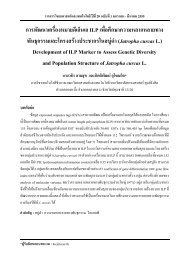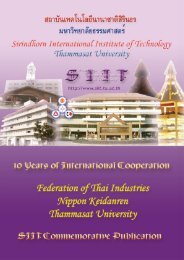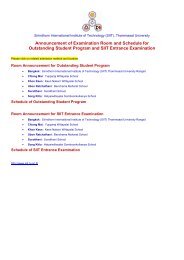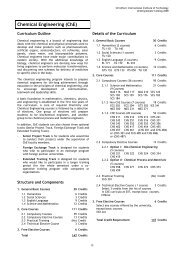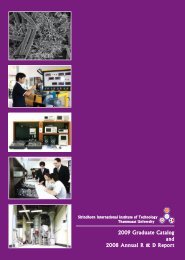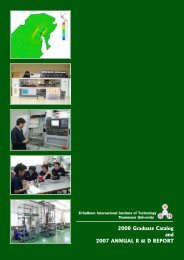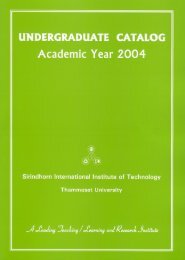2007 Graduate Catalog and 2006 Annual R & D Report - Sirindhorn ...
2007 Graduate Catalog and 2006 Annual R & D Report - Sirindhorn ...
2007 Graduate Catalog and 2006 Annual R & D Report - Sirindhorn ...
You also want an ePaper? Increase the reach of your titles
YUMPU automatically turns print PDFs into web optimized ePapers that Google loves.
<strong>2007</strong> <strong>Graduate</strong> <strong>Catalog</strong> <strong>and</strong> <strong>2006</strong> <strong>Annual</strong> R & D <strong>Report</strong><br />
<strong>Sirindhorn</strong> International Institute of Technology (SIIT)<br />
Dr. Pornpimol Chongphaisal<br />
Lecturer<br />
B.B.A. in Marketing, Assumption University, Thail<strong>and</strong><br />
M.A. in Comparative Management, Ritsumeikan University, Japan<br />
Ph.D. in Management, Ritsumeikan University, Japan<br />
Areas of Specialization: Intercorporate relations, Competencies <strong>and</strong> their applications in Human Resources<br />
Management, Organizational Behavior <strong>and</strong> Development.<br />
Research Interest:<br />
The “Intermediate Form” of Intercorporate<br />
Relations<br />
The traditional ‘make’ refers to a company making its<br />
own products whereas ‘buy’ refers to the transaction<br />
in the market, has become a problem of the past.<br />
Both ‘market’ <strong>and</strong> ‘organization’ as we know has its<br />
own sets of attributes. In making a transaction, a<br />
company has to select which is better between the<br />
two, taking into consideration the attributes <strong>and</strong> costs<br />
underlying each of them. A large diversified<br />
organization has the internal market for the goods,<br />
internal capital market, <strong>and</strong> internal labor market.<br />
Transactions in the middle range has been labeled<br />
differently as ‘hybrid transactions’, <strong>and</strong> ‘mixed<br />
coordination systems’. Dr. Pornpimol’s focus is on the<br />
study of these ‘intermediate forms’ which is not quite<br />
a complete integration into a single firm, but not quite<br />
an exchange between two separate firms in markets<br />
either. Firms may form links or bonds of a long term,<br />
‘relational’ nature, through which they become<br />
interdependent for business. The study covers not<br />
only the intercorporate shareholding <strong>and</strong> interlocking<br />
directorates but includes cases where the buyer may<br />
own tools used by the supplier or cases where there<br />
may be intensive technology transfer or sharing of<br />
technical <strong>and</strong> managerial knowledge between firms.<br />
The transaction efficiency, stemming from such a<br />
relationship, enables the parties involved to realize<br />
the reduction of production cost <strong>and</strong> transaction costs<br />
or its combination. Dr. Pornpimol observed the<br />
relationship between the cohesiveness of<br />
intercorporate relations <strong>and</strong> the reduction of<br />
transaction costs of a business group in Thail<strong>and</strong> <strong>and</strong><br />
compared it with those of Japan. Social network<br />
analysis is employed to quantitatively measure <strong>and</strong><br />
compare intercorporate shareholdings of the objects<br />
of study to underst<strong>and</strong> the changes of these<br />
relationships over time. The results implied by<br />
quantitative measurement are examined <strong>and</strong> logically<br />
explained in terms of the effects to the reduction of<br />
transaction costs.<br />
Dr. Somrote Komolavanij<br />
Associate Professor<br />
B.Eng. in Chemical Engineering, Chulalongkorn University, Thail<strong>and</strong><br />
M.S. & Ph.D. in Industrial Engineering, University of Texas at Arlington, USA<br />
Areas of Specialization: Engineering economy, Quality control, <strong>and</strong> Operations research.<br />
Research Interests:<br />
Applications of Fuzzy Sets Theory to Industrial<br />
Problems<br />
The theory of fuzzy set was proposed in the early<br />
1960s. It is suitable for applying to a problem where<br />
uncertainty is presented. The uncertainty can be the<br />
uncertainty of the data or the uncertainty of<br />
controlling rules. For example, capital budgeting<br />
problems usually require a lot of data for doing<br />
analysis <strong>and</strong> most of the data has to be estimated as<br />
it is future data. Examples of such data are many<br />
kinds of costs, interest rates <strong>and</strong> expected profit of<br />
the particular project, etc. Therefore, there will be<br />
uncertainty presented during the estimation process.<br />
For the uncertainty of controlling rules, fuzzy set<br />
theory can be used as the fuzzy decision-criteria to<br />
control the machine or the process to operate more<br />
efficiently or more economically.<br />
Engineering Economy<br />
Engineering Economy is the process that involves<br />
guidelines used for evaluating alternatives of<br />
investments. The research in this area will focus on<br />
the topics of investment analysis, replacement<br />
analysis, <strong>and</strong> mutually exclusive alternatives<br />
selections. Both deterministic <strong>and</strong> probabilistic<br />
capital budgeting models will be investigated.<br />
Operations Research<br />
The main purpose of research in this area is to<br />
minimize the cost or maximize the profit of what we<br />
are investigating. Mathematical models are used to<br />
represent the situation of the problem. They can be<br />
linear programming, non-linear programming, integer<br />
programming, dynamic programming model or job<br />
assignment model. After the type of model is<br />
selected <strong>and</strong> the model is developed, the optimal<br />
solution can be obtained by solving the model.<br />
Quality Control<br />
The application of quality control tools to improve the<br />
process is the main interest in this area. The research<br />
will include the application of Statistical Process<br />
Control (SPC), Sampling Plan, ISO 9000 <strong>and</strong> ISO<br />
14000.<br />
30




